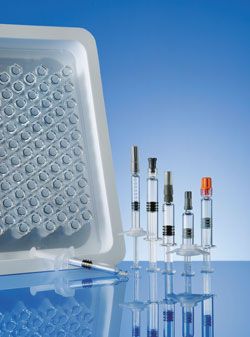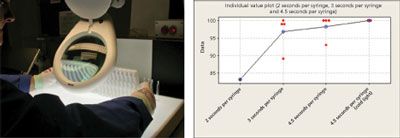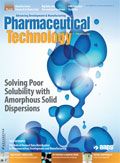Visual and Automated Inspection Technologies for Glass Syringes
To achieve the high quality standards required for critical defects in pharmaceutical glass syringes, a combination of visual and camera-based inspection technologies are used.
*Editor's Note: This article appeared in Pharmaceutical Technology Europe in October 2014

Regulatory authorities worldwide are paying more attention to the use of appropriate primary packaging materials and as a result, the trend is shifting towards more comprehensive and detailed standards. In 1997, the European Pharmacopeia devoted 19 pages on primary packaging materials. Eight years later, the number of pages had nearly tripled to 53 pages. The United States Food and Drug Administration guidelines on primary packaging materials have doubled from 26 pages in 1999 to 56 pages currently. For glass containers, higher quality means a reduction of particles, low crack rates or cosmetic defects and smaller tolerances on dimension with benchmarks well below the customary acceptable quality limits (AQL). To guarantee this level of quality, a range of prerequisites have to be met. The first prerequisite is a precise definition of the defect types that can occur and their causes. Based on this definition, it is possible to optimise the production processes and reduce the defect rate to the minimum. Process optimisation alone, however, is not sufficient to secure the desired defect rates.
In current specifications, the typical AQL is 0.01-0.065 for critical defects and 0.04-0.4 for major defects. To achieve the highest possible standard of safety, defect rates of ≤ 1 ppm for critical defects and ≤ 100 ppm for major defects are often required. From a quality management perspective, fully automated, camera-based inspection technology is the preferred approach. At the present state of the art, however, suitable inspection processes are not available for all defect types. In practice, manufacturers will continue to use a combination of automated and visual inspection technologies in the foreseeable future. The regulatory authorities require the submission of comprehensive process validation data obtained in case studies according to the quality-by-design (QbD) concept in the drug licensing process.
Syringe defects: Classification, causes and prevention

Glass syringes can show a range of defects that can be classified using different criteria. In the pharmacological context, the system of definition is based on the damage of glass integrity as it allows for an immediate assessment of the risk to doctors, nursing staff and patients. According to the Parenteral Drug Association’s Technical Report 43 (1) and the defect evaluation list (2), defects are classified in descending risk for cracks (critical), checks (major) and scratches (minor) (see Figure 1). It is an important prerequisite for reliable 100% inspection that the source, the root causes and the nature of these defects are well defined. The defects may originate at any occasion during the lifecycle of the container from glass forming through filling, packaging, labelling and shipping to final application.
A scratch is defined as a discontinuity of the glass matrix that is situated in the glass and may affect the integrity of the syringe. Consequently, scratches are rated as critical defects that may be hazardous to the health or even life of the patient. By contrast, checks are discontinuities in the glass that verifiably do not affect the integrity of the syringe. Checks, therefore, are rated as major defects that may cause problems in processing or applying the product. Scratches are superficial defects without damage of the glass matrix and thus are rated as minor. Other cosmetic defects, such as dirt, bubbles, air lines or glass particles, also fall into this category.
The production process of ready-to-fill glass syringes can be divided into three main phases. The first phase is the forming, comprising the cutting of the glass tubes and the multistep process of forming the shoulder, cone and finger flange of the syringe. In the second phase, the needle is glued in. Subsequently, the syringe is washed, siliconised, sterilised and packed.
Cracks, the most severe type of defects, mostly occur in the cutting and forming steps or as a result of an inadequate annealing of the glass. The root causes for cracks are nearly completely thermic--be it a thermic shock caused by too large or badly oriented quantities of water in the cutting process, too high temperature differences between glass and tools in the forming process or flaws in the annealing process. Beyond the optimisation of process parameters, cracks can be avoided by the reduction of temperature differences in the processing of the syringes. Checks and scratches, on the other hand, result mostly from glass-to-glass and glass-to-metal contacts or other mechanical strains in further production. Efficient measures to avoid these defects, therefore, are the avoidance of these forms of contact as well as gentle transport processes.
Visual inspection: Minimising the human factor
In any reliable visual inspection process, an awareness of and control over all relevant input variables are essential, as is a viable model of their interaction. It is also important to remember that validation only applies to a defined input range of the defect rate. If there are too many input defects, the target output value will be exceeded. In addition to the false pass rate, the input defect rate has to be known and monitored. If it becomes too high, the production line has to be stopped for both economic and quality-related reasons so that the cause can be investigated.
In the validation process, it is essential to understand the visual inspection as a structured process with a known number of variables. Some of the input variables relate to the choice of personnel who must satisfy certain requirements of visual performance and concentration capability. The inspectors also have to be properly trained and attend regular refresher workshops to sustain the learning effect.
Another group of input variables relate to the technical design of the inspection process. The main ones are light-related factors such as the colour and direction of the inspection light source and the design of the background surface on which the inspections are performed.
A third group of input variables relate to the ergonomics of the inspection process, which include the design of the inspection workstation, whether the inspectors take enough breaks from their work and whether they are supported in the inspection process by visual timers such as changing light colour. This aspect is particularly significant because the time taken to inspect each syringe has a high influence on visual inspection output quality.
An efficiency study shows the complex interactions of the individual input variables. The four people surveyed--two experienced and two less experienced inspectors--were given a number of syringes to inspect over a period of 40 minutes in a production environment. There were a known number of defective products in the batch of syringes, whereby the defect rate was deliberately set at the upper limit for typical defects. The defects themselves were small in size to create challenging test conditions. The time variables in the study deviate from the actual time variables in the production environment.
Figure 2 shows the overall performance of the people surveyed with different inspection timeframes and conditions. One key survey finding is that the time spent on the inspection of each product is extremely significant. With a time allowed of 2 seconds per syringe, the performance of all the inspectors was weak and they identified less than 85% of the defective products. Even the experienced inspectors did not perform adequately in unfavourable conditions. When the time allowed for inspection was increased to 3 and 4.5 seconds, respectively, the results improved considerably. However, there was some degree of difference, which indicates the significance of individual visual performance. The number of defects identified by three out of the four inspectors improved substantially (though not completely identically) when the time allowed for inspection was increased to 3 seconds, while one inspector’s performance deteriorated considerably. This difference in performance remained unchanged when the time allowed for inspection was increased to 4.5 seconds. In fact, it did not improve until another input variable was changed.

In the first three tests, a diffuse overhead light source was used. Another test sequence was then performed with a cold light source and optical conductors that bundled the light axially into the syringe barrels, making cosmetic defects highly visible. Under these conditions all inspectors, including the inspector with lower visual performance, detected 100% of the defects. Another significant result of the study, in addition to the need to allow an appropriate time for inspection of each product, is that the individual variability of test results could be effectively influenced by changing the test process structure. Another important consideration is that the results cannot be generalised. The inspection conditions for a product or product group have to be established on a case-by-case basis and depend on how easy or difficult product-specific defects can be identified.
Camera-based inspection: Automated detection technologies for dimensional and attribute defects
Camera-based inspection systems to inspect the dimensions of syringes can achieve a resolution of up to 20 µm with measurement uncertainty of only 2 µm (see Figure 3). They are, therefore, far superior to visual inspections, though not necessarily superior to mechanical inspection methods (e.g., use of calipers) for the inspection of complex three-dimensional geometries such as the shape of the finger flange. If the syringe is rotated during the camera inspection process, however, reliable results are achieved. The advantages of camera systems are particularly evident in the identification of needles with bent tips, which, if undetected, would cause pain to the person being treated.

Camera-based inspection systems perform far more complex tasks in the identification of cosmetic defects. The detection limit is currently defined by an area of 0.1 mm2 and this will be reduced to 0.03 mm2 in the foreseeable future. As in visual inspections, camera-based inspections have to ensure a defect rate of ≤1 ppm for critical defects. The automated systems can tolerate a far higher input defect rate than visual inspections. However, there is a limit for process validation purposes, and the production line has to be stopped if the input defect rate gets too high. A reliable inspection can only be guaranteed if the false pass rate and the input defect rate are known and continuously monitored.
Input variables. A range of relevant input variables have to be taken into consideration in the validation process. One is the minimum size of the defect and an agreement has to be reached with the customer in this respect. A second typical defect characteristic is the contrast that it produces in the camera image, which is displayed as a greyscale difference. For example, impurities generally only create low contrasts, while defects in the glass matrix such as cracks create reflections if the light is traveling in the right direction, and therefore, high contrasts. It is more and more common to agree with the customer on the lower limits for defect relevance to achieve transparent quality criteria that apply for both the customer and the manufacturer. Camera-specific identification limits and measuring inaccuracies exist with regard to defect size and contrast that have to be taken into account in the validation and in regular calibrations.
The third significant block of input variables, in addition to defect and camera characteristics, relate to inspection conditions. Firstly, all optical variables of the light sources used, such as luminosity, colour and direction, have to be optimally coordinated and kept constant. The direction of the camera, syringe and light source also have to be coordinated. The light should pass axially through the syringe to maximise defect visibility. Rotating the syringe permits the inspection of the entire surface area. Because some types of cracks will remain undetected if the camera is at a right angle to the light source, it makes sense to use a more acute inspection angle or work with two cameras.
Camera validation. In practice, camera validation involves six steps (see Figure 4). The first step is to create a library of all defect types to be identified with both physical samples and photos of the defects. In the second step, the samples are used to create camera protocols and defect-specific algorithms for each defect. These algorithms can be very complex. Air lines in the glass create an interrupted pixel pattern whose individual elements would be below the relevance limit. This is where the algorithm comes in, because it recognises the linear sequence of greyscale differences and adds them together into a relevant total length.

The third step is the creation of samples which define the tolerances for each defect. Using tolerance samples, the corresponding tolerance parameters can be defined for the camera. In the fourth step, the false pass rate is measured on the basis of the defined parameters. Sometimes, the parameters have to be adjusted to guarantee the required output quality. The fifth step is the definition of an upper limit for input defects that would trigger a production alarm. In the sixth and final step, the actual output quality is verified on the basis of a comprehensive performance qualification.
In a diagram representing the dimensions of defect contrast and defect size, it is possible to systematically illustrate the typical optical characteristics of cosmetic defects and their detectability with camera-based inspection systems (see Figure 5). Small, low contrast and, therefore, difficult-to-detect defects are shown at the top left of Figure 5 while particularly large and high contrast defects that are easy to detect are shown at the bottom right. This shows, for example, that scratches and checks are often difficult to identify in practice, whereas cracks (with few exceptions) deliver large and high contrast defect patterns.

A system of inspection limits is defined in the diagram taking the camera system’s power, the defect’s level of criticality and the relevant quality agreement into account. Not only is a lower limit for size and contrast defined, but also a matrix of 3 x 3 areas (delineated by the red lines). The camera software can be set up in such a way that it considers signals in each of these areas as defect. In the example of Figure 5, there are in total six areas that are designated as “activated.” All signals with parameters of defect size and defect contrast appearing in these areas would be considered as defect by the camera software. Defects with size above 0.1 mm² and contrast of over 1:60 are activated. The area with a defect size of above 0.4 mm² and a defect contrast of between 1:60 and 1:30 is also activated. For safety reasons, the segment of small, high contrast defects at the bottom left is also activated, even though there are no defects shown there in this diagram. Fields in which defect detection is technically unfeasible or not necessary on the basis of the agreed quality criteria are not activated.
Camera-based systems for dimensional inspections are available for practically all relevant syringe dimensions. Gerresheimer AG performs automated camera inspections as standard on the syringe barrel, neck/shoulder, cone, finger flange and needle, as well as on the positioning of the closure. Automated camera inspections for cosmetic defects in needle quality are also performed as a standard procedure. Cosmetic defect inspections of the syringe barrel, neck/shoulder, finger flange and printing can also be agreed upon with clients. A cosmetic inspection of the closure can be performed by the supplier. Gerresheimer AG is currently working on concepts for inspecting the cone and siliconisation for cosmetic defects.
Inspecting in the future
At the current time, both visual and camera-based technologies are used to inspect glass syringes. Despite the dependency on the individual inspectors’ performance, visual inspections deliver the required output quality, if the personnel is properly trained and the inspection conditions are appropriate and continuously monitored. However, camera-based inspection technology is more reliable if ppm or sub-ppm level defect rates have to be achieved. Here, too, knowledge and control of all relevant input processes are essential for validation. Gerresheimer AG has developed its own camera technology for the most important defect types. In the future, new technologies will be capable of detecting defect types that are not identifiable at this time.
References
- Parenteral Drug Association, PDA Technical Report No. 43, Identification and Classification of Nonconformities in Molded and Tubular Glass Containers for Pharmaceutical Manufacturing, Revised 2013 (TR 43) (Bethesda, MD, 2013).
- M.Harl, S.Horst, M.Polan, Defect Evaluation List for Containers Made of Tubular Glass, 4th edition (Editio Cantor, Aulendorf, 2009).
About the AuthorBernhard Hinsch, PhD, is formerly director, Quality Management Tubular Glass Europe, Gerresheimer AG,and now retired and working as a consultant at Hinsch-Consulting, Hamburg, Germany.
All correspondence should be addressed to
Felix Weiland, PhD, director, Quality Management, Gerresheimer Bünde GmbH, Erich-Martens-Strasse 26-32, 32257 Bünde, Germany
T: +49 5223 164 419,
F: +49 5223 164 397
E: f.weiland@gerresheimer.com.

Drug Solutions Podcast: A Closer Look at mRNA in Oncology and Vaccines
April 30th 2024In this episode fo the Drug Solutions Podcast, etherna’s vice-president of Technology and Innovation, Stefaan De Koker, discusses the merits and challenges of using mRNA as the foundation for therapeutics in oncology as well as for vaccines.
Pharmaceutical Tariffs Are Imminent: How Industry is Bracing for Impact
April 16th 2025On April 14, 2025, the Trump Administration launched a national security-driven investigation into pharmaceuticals, a move that will likely result in tariffs being placed on pharmaceutical drugs, ingredients, and other components that are imported from outside of the United States.